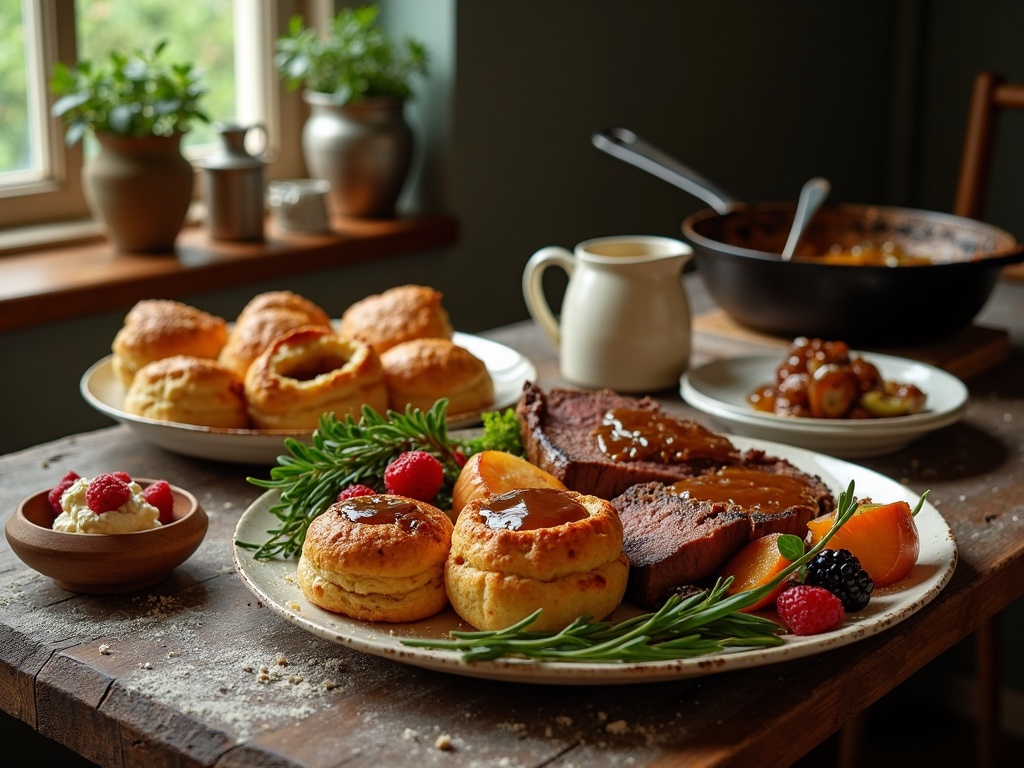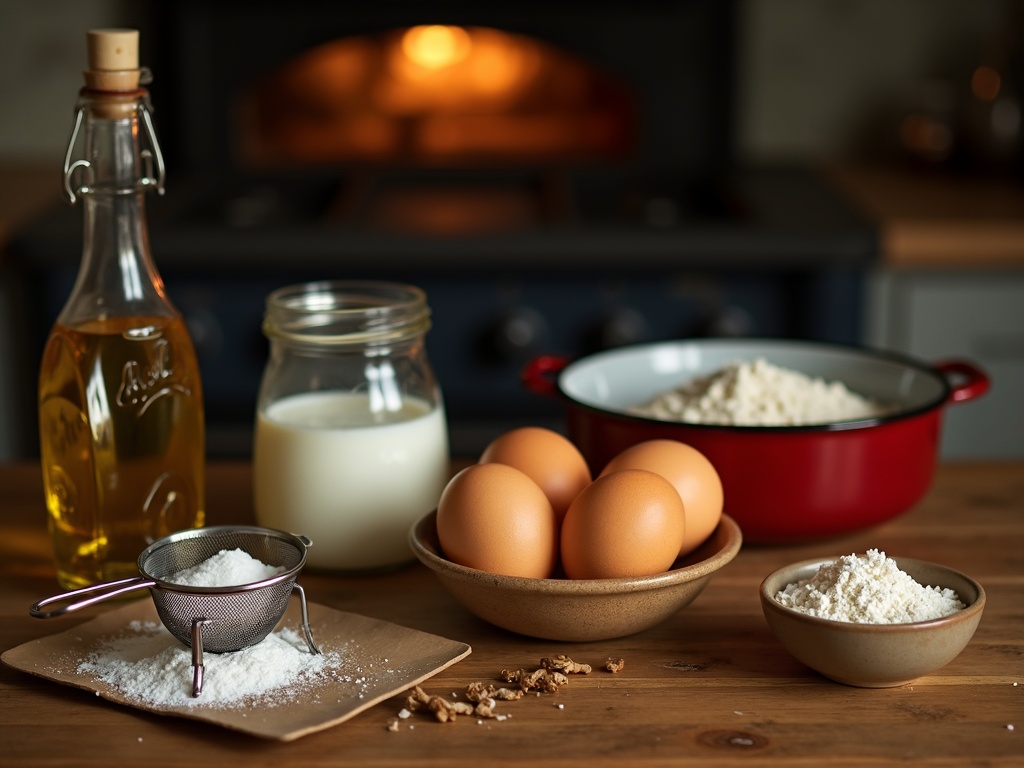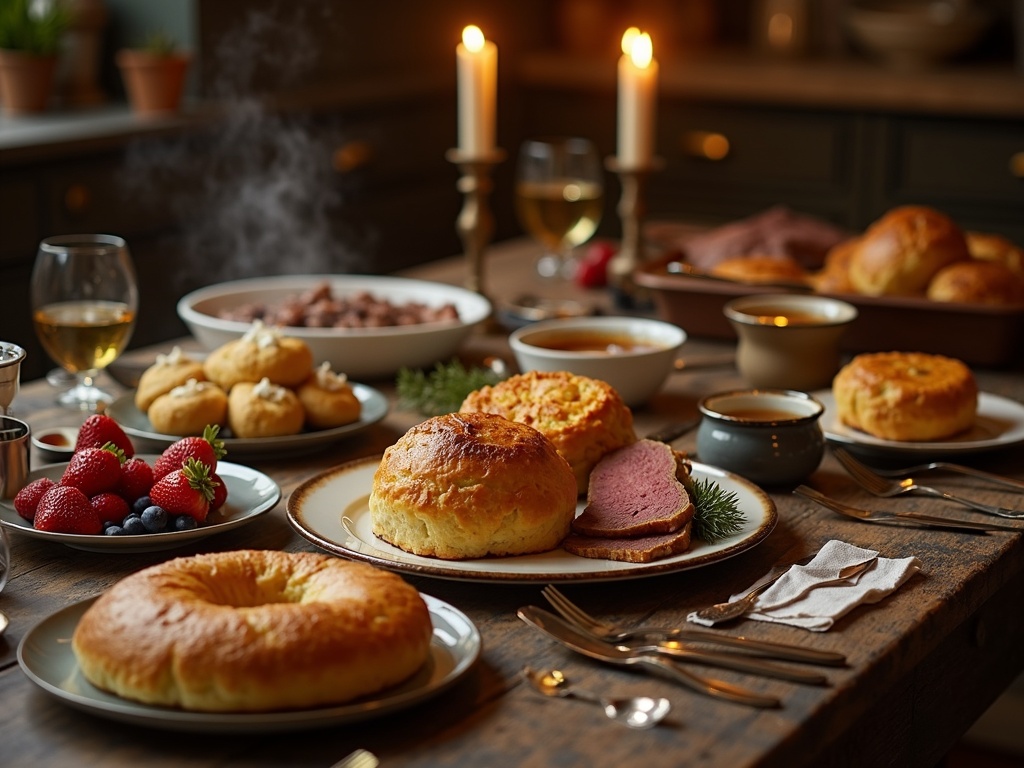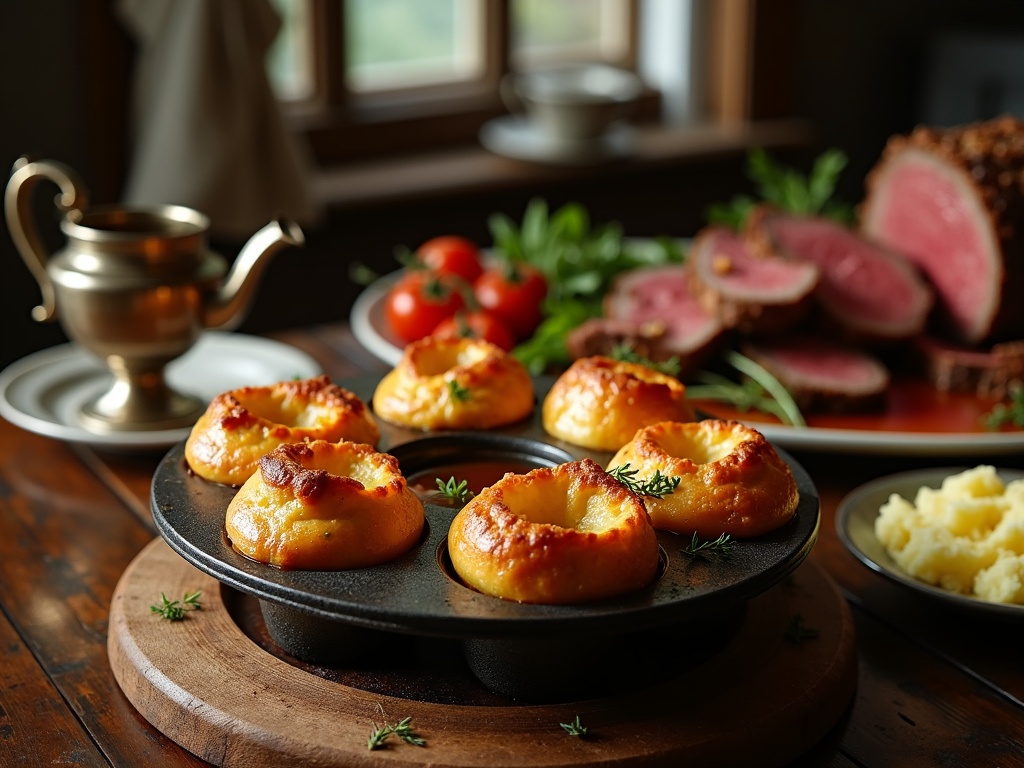Yorkshire Pudding: A Timeless British Favorite
Yorkshire pudding Recipe, a beloved British dish dating back to the 18th century, evolved from a simple way to utilize meat drippings into a crucial component of traditional Sunday roasts. These puffy, golden creations achieve their dramatic rise when cold batter hits hot oil, creating the perfect contrast between crispy exteriors and soft, airy centers.
Table of Contents
Key Takeaways
- Success requires room temperature ingredients such as eggs and milk, and letting the batter rest for 30–60 minutes before baking.
- The oil must be smoking hot (220°C/425°F) before adding the batter in order to achieve the characteristic rise.
- Fill pudding tins only one-third full and avoid opening the oven during baking to prevent collapse.
- The perfect ratio is 1 part eggs to 1 part flour to 1 part liquid; metal tins produce better results than glass or ceramic alternatives.
- Yorkshire puddings are versatile—traditionally served with roast beef, but can also be filled with sweet or savory ingredients for creative variations.
Tips for the Perfect Rise
I’ve found that achieving that perfect rise depends entirely on temperature contrasts. The cold batter needs to hit oil that’s almost smoking—this creates instant steam that pushes the batter upward. My best results come from letting ingredients reach room temperature first, then giving the mixed batter time to rest before it hits that scorching hot oil.
Metal tins conduct heat better than glass or ceramic alternatives. I always preheat my tins with oil until the surface shimmers before pouring in the batter. The dramatic puffing happens in the first few minutes of baking, so I never open the oven door during this critical period.
The Perfect Sunday Roast Companion
Yorkshire pudding stands as an iconic British dish with a rich heritage dating back to the 18th century. Originally developed in Yorkshire, England, these savory puddings were created as a clever way to make use of meat drippings while stretching meals for families on tight budgets. Cooks would position a pan of batter beneath roasting meat, allowing the fat to drip down and create a crispy, flavorful accompaniment.
Today, I consider Yorkshire puddings an essential element of any proper Sunday roast — their golden, puffy appearance bringing a touch of tradition and flair to the dinner table.
The beauty of Yorkshire puddings lies in their versatility. While they’re traditionally served alongside roast beef, I’ve found they pair wonderfully with cottage pie for a hearty meal or can even inspire dessert variations similar to a sticky toffee pudding recipe.
The Science Behind Perfect Yorkshire Puddings
The magic of a Yorkshire pudding happens when hot oil meets cold batter, creating instant steam that makes the pudding rise dramatically. This reaction is what gives Yorkshire puddings their signature characteristics — crispy, golden-brown edges and a soft, airy center. Getting this balance right transforms a simple batter into something extraordinary.
The perfect Yorkshire pudding should have:
- A dramatically risen structure with a defined “well” in the center
- Crispy, nearly brittle outer edges that provide textural contrast
- A soft, slightly eggy interior that’s cooked through but not dry
- A golden-brown color indicating proper heat exposure
Temperature control plays a crucial role in achieving these qualities. I’ve discovered that preheating your oil or fat until it’s smoking hot (around 220°C/425°F) creates the initial “shock” needed for maximum rise. This high heat immediately sets the exterior while allowing the interior to cook more gradually, creating that perfect contrast between crisp and soft textures.
Traditional Techniques with Modern Twists
While traditional recipes call for beef drippings, I’ve found several alternatives that work brilliantly for different dietary needs. Vegetable oil, duck fat, or even clarified butter can produce excellent results with subtly different flavor profiles. The key factor isn’t necessarily the type of fat but ensuring it reaches the proper temperature before adding your batter.
The resting period for Yorkshire pudding batter remains somewhat controversial among chefs. Some insist on resting the batter for several hours, while others claim immediate baking works best. In my experience, a 30–60 minute rest allows the gluten in the flour to relax while the ingredients fully incorporate, resulting in a more consistent rise and texture.
For those who enjoy experimenting with flavors, Yorkshire pudding batter accepts herbs and seasonings beautifully. A pinch of dried thyme or rosemary can complement a seasonal dessert like rhubarb crumble when served together. For a more substantial variation, I sometimes add caramelized onions or cheese to the batter, creating a savory option that pairs wonderfully with marry me chicken or other main courses.
Yorkshire pudding’s simplicity makes it an excellent candidate for kitchen experiments. The basic ingredients — flour, eggs, milk, and salt — create a canvas for countless variations. I’ve seen creative cooks transform the basic recipe into everything from sweet breakfast options (similar to American pancake recipes) to dessert vessels filled with cream and berries, reminiscent of a deconstructed Biscoff cheesecake.
Whatever your approach, mastering Yorkshire puddings brings a sense of culinary achievement and allows you to participate in a cooking tradition that has brought joy to dinner tables for generations.

Essential Ingredients for Success
Getting Yorkshire puddings right is all about starting with the proper ingredients. I’ve found that using high-quality basics makes all the difference between flat, disappointing puddings and those gloriously puffy creations that steal the show at Sunday dinner.
The Perfect Yorkshire Pudding Formula
The magic of Yorkshire puddings comes from a simple but specific combination of ingredients:
- 4 large fresh eggs – These provide the structure and lift. I always use room temperature eggs as they incorporate better into the batter. Cold eggs straight from the fridge can result in a less airy finished product.
- 1 cup all-purpose flour – The foundation of your puddings. While some recipes call for specialty flours, regular all-purpose works perfectly. Just make sure to sift it to avoid any lumps that could weigh down your puddings.
- 1 cup whole milk – The fat content in whole milk is crucial for flavor and texture. I’ve tried using lower-fat alternatives, but they just don’t produce the same rich results. Like the eggs, milk should be at room temperature before mixing.
- 1/2 teaspoon salt – This small amount enhances all the flavors without making the puddings taste salty. Don’t skip this simple ingredient!
- 2 tablespoons vegetable oil or beef drippings – This is where tradition meets function. While vegetable oil works well, beef drippings add an incredible depth of flavor that pairs beautifully with traditional British comfort foods. The hot fat is essential for creating that initial sizzle when the batter hits the pan.
The ratio of these ingredients creates the perfect balance – enough protein from the eggs to create structure, enough liquid for steam, and enough fat for that beautiful golden exterior.
The quality of ingredients matters tremendously. Fresh eggs with bright, orange yolks will give your puddings a richer color and better rise than older eggs. Similarly, your choice of fat will impact the final flavor profile – many Yorkshire pudding enthusiasts insist that beef drippings are non-negotiable for their distinct savory quality that complements dishes like traditional British desserts that might follow your meal.

Steps to Yorkshire Pudding Glory
Preparing the Perfect Batter
I start by creating a smooth, lump-free batter which forms the foundation of great Yorkshire puddings. First, crack eggs into a large mixing bowl and whisk them thoroughly. Then gradually add flour while continuing to whisk, preventing any lumps from forming. Slowly pour in milk as you mix, creating a batter with the consistency of heavy cream. Add a pinch of salt for flavor enhancement.
The resting stage is crucial for Yorkshire pudding success. Let the batter sit at room temperature for at least 30 minutes, though I’ve found an hour produces even better results. This resting period allows the starch molecules in the flour to fully absorb the liquid, creating that characteristic rise when baked.
The Hot Oven Technique
While the batter rests, I preheat my oven to a hot 425°F (220°C). The high temperature is non-negotiable for achieving that dramatic rise and crispy exterior. About 10 minutes before the batter’s rest time concludes, I place my pudding tin with a small amount of oil in each section into the hot oven.
The oil must be smoking hot before adding the batter – this is the secret to that impressive puff. Once properly heated (typically 5-7 minutes), I quickly but carefully pour the batter into the sizzling oil-filled sections, filling each about halfway.
The puddings need 20-25 minutes of undisturbed baking. Opening the oven door prematurely can cause them to collapse, so I resist the temptation to peek. They’re done when puffed dramatically with a deep golden brown color.
These Yorkshire puddings make a fantastic accompaniment to a traditional cottage pie for a complete British dinner experience. If you enjoy British classics, you’ll also love making a sticky toffee pudding for dessert.
Yorkshire Pudding Tips for Success
For the best results when making Yorkshire puddings, keep these key points in mind:
- Ensure all ingredients are at room temperature before mixing
- Don’t overmix the batter – stop when just smooth
- Never skip the resting period
- Make sure the oil is properly smoking hot before adding batter
- Don’t open the oven during baking
Once you’ve mastered Yorkshire puddings, you might want to try other British classics like rhubarb crumble to round out your culinary skills.
Common Mistakes to Sidestep
I’ve made countless Yorkshire puddings over the years and learned some hard lessons along the way. Creating the perfect Yorkshire pudding requires attention to detail, and even small errors can lead to flat, soggy results rather than those gloriously crisp, golden puffs we all aim for.
Timing and Temperature Pitfalls
Opening the oven door while baking is perhaps the most common Yorkshire pudding crime. That quick peek might seem harmless, but it causes a temperature drop that prevents proper rising. I always wait until they’re at least three-quarters done before even thinking about checking on them.
Another crucial mistake is using cold ingredients straight from the refrigerator. For best results, eggs and milk should be at room temperature before mixing your batter. This simple step creates a smoother mixture and promotes better rising. I often prepare my ingredients an hour before I start cooking my cottage pie or other main dishes to give everything time to warm up.
Overfilling the tins is a rookie error I made repeatedly when starting out. Fill your tins only one-third full with batter – they need space to expand dramatically.
Not preheating the oil properly is another common downfall. The oil should be smoking hot before you pour in the batter. This initial heat shock is what creates that perfect rise. I heat my oil for at least 10 minutes while preparing my rhubarb crumble or other desserts.
Setting an incorrect oven temperature can ruin your efforts entirely. Yorkshire puddings need high heat – around 220°C (425°F) – to rise properly. Lower temperatures won’t create enough steam to make them puff up, while temperatures that are too high might burn them before they’re cooked through.
I’ve found that maintaining a consistent baking environment is essential. My kitchen can get quite busy when preparing a full Sunday roast, but I’m careful to keep the area around the oven calm to prevent temperature fluctuations. Once your puddings come out perfect, they pair beautifully with savory dishes or can be served with sweet toppings like those used in sticky toffee pudding for a unique dessert.
By avoiding these common mistakes, your Yorkshire puddings will rise tall and proud every time, adding that perfect crispy complement to your Sunday roast or special dinner.
Secret Tips for Perfect Results
Getting those perfectly risen, crispy yet soft Yorkshire puddings can be challenging, but I’ve discovered some game-changing secrets that make all the difference. These tips have transformed my Yorkshire pudding game from disappointing to spectacular.
Preparation Is Everything
Room temperature ingredients are crucial for Yorkshire pudding success. I always take my eggs and milk out of the refrigerator at least 30 minutes before mixing the batter. Cold ingredients can cause the batter to seize when it hits the hot oil, preventing that dramatic rise we’re all looking for.
The consistency of your batter is another make-or-break factor. I aim for a texture similar to heavy cream—not too thick, not too thin. This perfect consistency allows the puddings to rise beautifully while maintaining their structure. If your batter seems too thick, add a little more milk; if it’s too runny, a touch more flour will fix it.
Cooking Techniques That Make A Difference
Positioning your baking tray correctly can significantly impact your results. I’ve found that placing the rack in the middle of the oven provides the most even heat distribution, helping the puddings rise consistently without burning. Too high, and the tops may brown too quickly; too low, and they might not reach their full height potential.
The type of tin you use matters tremendously. Metal tins, particularly cast iron or heavy-duty muffin tins, conduct heat much better than glass or ceramic alternatives. I’ve switched to using metal tins exclusively for my Yorkshire puddings and other traditional desserts, and the difference is remarkable.
After your puddings are beautifully risen and golden, resist the urge to pull them straight from the oven into room temperature. This sudden temperature change can cause them to collapse dramatically. Instead, I open the oven door slightly and let them cool gradually for a few minutes before serving. This cooling technique helps maintain that impressive structure.
These tips might seem simple, but they’ve completely transformed my Yorkshire pudding results. The satisfaction of watching those perfect puddings emerge from the oven, with their crisp exterior and soft, pillowy interior, makes the attention to detail worthwhile. Perfect Yorkshire puddings can elevate a simple British meal to something truly special, and these secrets will help you achieve restaurant-quality results at home.
Serving Suggestions
Yorkshire puddings add a delightful touch to any meal when served correctly. I’ve discovered several ways to enjoy these puffy delights beyond the traditional Sunday roast.
Traditional and Alternative Serving Ideas
The classic pairing for Yorkshire puddings will always be alongside a succulent roast beef dinner. The crispy exterior and soft, doughy middle create the perfect vessel for soaking up rich beef juices. I like to serve one large pudding per person or several smaller ones arranged attractively on the plate.
When it comes to gravy, not all options are created equal. For an authentic experience, I recommend:
- Beef gravy made from the roasting pan drippings
- Onion gravy for a sweeter flavor profile
- Mushroom gravy for a vegetarian alternative
Looking beyond tradition, Yorkshire puddings can be wonderfully versatile. Try these creative serving ideas:
- Fill mini puddings with smoked salmon and cream cheese for elegant appetizers
- Create a “toad in the hole” by baking sausages directly in the batter
- Serve sweet Yorkshire puddings with fresh berries and whipped cream for dessert
- Use as an edible bowl for hearty stews or chili
After enjoying your meal, you might have leftover puddings that need storing. They keep well in an airtight container at room temperature for up to 24 hours or in the refrigerator for 2–3 days. For longer storage, freeze them in freezer bags for up to one month.
When it’s time to reheat, avoid the microwave which makes them soggy. Instead, place them on a baking sheet in a preheated 350°F (175°C) oven for 5–8 minutes until crisp and heated through. This method restores their delightful texture, giving them a second life almost as good as fresh.
For a complete traditional British experience, consider serving your Yorkshire puddings alongside homemade cottage pie or follow them with a classic sticky toffee pudding for dessert. If you’re looking for a seasonal twist, they pair beautifully with tangy rhubarb crumble as part of a full Sunday lunch spread.

Troubleshooting Your Puddings
Making perfect Yorkshire puddings can sometimes feel like a culinary puzzle. When those golden puffs fail to deliver, there’s usually a specific reason behind it. I’ve gathered solutions for the most common Yorkshire pudding problems to help you avoid disappointment on your next Sunday roast.
Why They Didn’t Rise and How to Fix Them
Yorkshire puddings that refuse to puff up can be incredibly frustrating. Here are the main culprits behind flat puddings:
- Temperature issues: Your oven or oil wasn’t hot enough before adding the batter. The oil should be smoking hot!
- Overmixing: This develops too much gluten and makes the puddings tough rather than light and airy.
- Opening the oven: Peeking during cooking causes temperature drops that deflate your puddings.
- Old batter: For best results, use freshly made batter rather than one that’s been sitting around.
If your puddings are consistently soggy in the center, it’s typically because they haven’t cooked long enough. You might be tempted to remove them when the tops look golden, but this can leave the inside undercooked. Much like American pancakes that need proper timing, Yorkshire puddings need adequate heat exposure throughout.
Achieving Perfect Results Every Time
Uneven cooking often happens when your oven has hot spots or when puddings are crowded too closely together. I rotate my tray halfway through cooking for consistent results, making sure there’s adequate space between each pudding cup.
To prevent that disappointing collapse that sometimes happens as puddings cool, make sure they’re thoroughly cooked before removing from the oven. A properly cooked Yorkshire pudding should have a firm structure that maintains its shape.
Another trick is to create a small hole in the center once they’re cooked. This releases steam and helps prevent the sudden deflation that can occur with rapidly cooling puddings.
For those who enjoy other British classics, techniques learned from making sticky toffee pudding or cottage pie can also apply here – patience and proper temperature control are key.
Remember that achieving consistent results might take practice. Yorkshire puddings follow scientific principles – the hot oil causes the water in the batter to evaporate quickly, creating steam that puffs up the batter. Any factor that disrupts this process will affect your final result.
Once you’ve mastered troubleshooting these common issues, you’ll find your Yorkshire puddings rising magnificently every time, ready to accompany your roast dinner with their crisp exteriors and perfectly cooked centers.

Expert Baker’s Notes
After making Yorkshire puddings for decades, I’ve picked up essential tips that transform an ordinary recipe into spectacular, towering puffs. The little details can make or break your Yorkshire success, so let’s dive into what really matters.
Flour, Milk, and Make-Ahead Magic
For the best Yorkshire puddings, flour selection is crucial. Plain all-purpose flour creates a reliable baseline, but for exceptional height and structure, I prefer a strong bread flour. The higher protein content develops better gluten networks that trap steam effectively during baking. For a lighter texture, I sometimes blend bread and plain flour in a 50:50 ratio. Avoid self-rising flour completely—the added leavening agents will cause irregular rising and collapse.
Milk alternatives work surprisingly well in Yorkshire puddings. While traditional recipes call for whole cow’s milk, I’ve had excellent results with:
- Oat milk: Creates a slightly nuttier flavor with comparable rise
- Almond milk: Makes a lighter texture but offers less browning
- Soy milk: Provides good protein structure similar to dairy milk
- Semi-skimmed or skim milk: Work perfectly for a lighter version
The full-fat versus low-fat debate isn’t as critical as ensuring your batter has adequate protein structure and consistent temperature.
Making Yorkshire pudding batter ahead of time isn’t just convenient—it improves the final result. I suggest preparing the batter at least 30 minutes before baking, but ideally 3–4 hours ahead. This resting period allows the flour to fully hydrate and the gluten to develop properly. For convenience, I often make my batter the night before and refrigerate it covered. Just remember to let it come back to room temperature about 30 minutes before baking.
Scaling a Yorkshire pudding recipe requires understanding the basic ratio. My foolproof formula is 1 part eggs to 1 part flour to 1 part liquid. This scales beautifully whether making a small batch or catering for twenty people at Sunday lunch.
For a family of four, I typically use:
- 4 large eggs
- 225g (1 cup) flour
- 225ml (1 cup) milk
- Pinch of salt
This yields 8–10 medium Yorkshire puddings in a standard muffin tin. When doubling or halving, maintain this ratio precisely.
Temperature remains the non-negotiable element regardless of batch size. Your fat must be smoking hot before adding batter—this creates the initial steam explosion that forms the characteristic hollow center. I heat my tin with oil for at least 10 minutes at 220°C (425°F) before pouring batter.
The perfect companion to Yorkshire puddings is a rich, hearty cottage pie—the puddings are ideal for sopping up all that delicious gravy. For dessert, consider a traditional rhubarb crumble to complete your British-inspired meal.
When reheating day-old Yorkshires (if you ever have leftovers!), avoid the microwave which makes them tough. Instead, refresh them in a hot oven for 3–4 minutes. They’ll regain much of their original crispness without drying out completely.
Don’t be discouraged by failed attempts—even experienced bakers occasionally produce flat puddings. The most common issues are opening the oven door too soon (causing collapse) or using ingredients at different temperatures. Keep your eggs, milk, and flour at room temperature for the most consistent rise every time.

